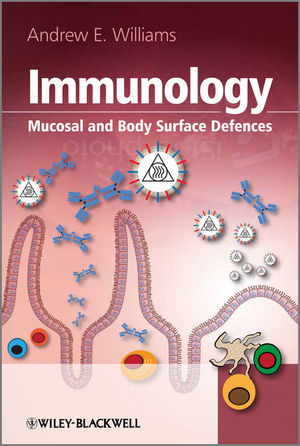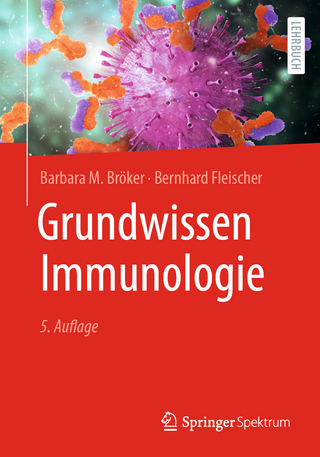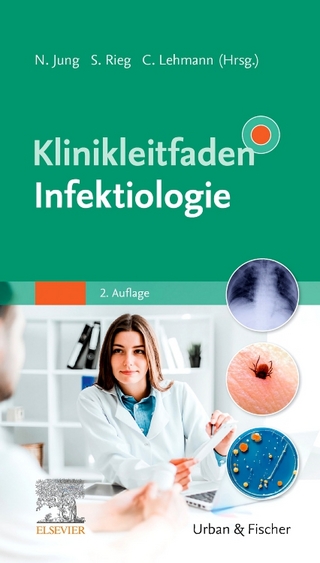
Immunology
Wiley-Blackwell (Verlag)
978-0-470-09003-9 (ISBN)
- Titel ist leider vergriffen;
keine Neuauflage - Artikel merken
2012 PROSE Award, Clinical Medicine: Honorable Mention The vast majority of medically important pathogens infect their host across a body surface such as the skin, or across a mucosal tissue such as the respiratory tract or intestines, as these sites are the ones exposed to the external environment. By focusing on immunity at mucosal and body surfaces this book presents a fresh, new approach to the teaching of immunology. After an introduction to the basic structure of the immune system, the book looks at two important families of signalling molecules: cytokines and chemokines, before covering the workings of the mucosal immune system. It continues by examining immunity against the four major groups of pathogens - viruses, bacteria, fungi and parasites, and concludes by looking at disorders of the immune system, mucosal tumour immunology and the process of vaccination. * A fresh, new approach to the subject focusing on mucosal and body surfaces. * Describes the mucosal immune systems of the gastrointestinal, respiratory and urogenital tracts, as well as the skin. * Details the important roles of cytokines and chemokines in an immune response.
* Separate chapters devoted to immunity against viruses, bacteria, fungi and parasites. * Includes chapter summaries, boxes with topics of special interest and an extensive glossary. * Clearly written and well- illustrated in full colour throughout. Students across a range of disciplines, including biology, biochemistry, biomedicine, medicine and veterinary sciences, will find this book invaluable, both as an introduction to basic immunology and as a guide to mucosal immune defence mechanisms.
Dr Andrew E. Williams, Imperial College, London, UK.
Preface, xv List of Standard Cells and Symbols, xvii 1 Basic Concepts in Immunology, 1 1.1 The immune system, 1 1.2 Tissues and cells of the immune system, 1 1.3 Activation, regulation and functions of immune responses, 4 1.4 Innate versus adaptive immunity, 5 1.5 Primary and secondary immune responses, 6 1.6 Immune cell development, 7 1.7 Mast cells and basophils, 9 1.8 Eosinophils, 11 1.9 Neutrophils, 11 1.10 Monocytes and macrophages, 11 1.11 Dendritic cells, 12 1.12 Natural killer cells, 12 1.13 CD4+ T helper cells, 13 1.14 CD8+ cytotoxic T cells, 14 1.15 B cells, 15 1.16 T cells, 16 1.17 Natural killer T cells, 16 1.18 Anatomy of the immune system, 16 1.19 Lymph nodes, 16 1.20 Spleen, 19 1.21 Summary, 19 2 The Innate Immune System, 20 2.1 Introduction to the innate immune system, 20 2.2 Innate immune receptors and cells, 20 2.3 TLRs and pattern recognition, 22 2.4 TLR signalling in response to LPS, 23 2.5 Peptidoglycan and Nods, 24 2.6 Nod-like receptors recognize PAMPs and DAMPs, 25 2.7 Damage associated molecular patterns (DAMPs), 26 2.8 Complement proteins perform several innate immune functions, 27 2.9 The classical complement pathway, 28 2.10 The lectin and alternative complement pathways, 29 2.11 Biological properties of complement cleavage products, 29 2.12 Opsonization by complement proteins, 30 2.13 Phagocytosis, 31 2.14 Fc receptors induce phagocytosis, 32 2.15 Neutrophil function and the respiratory burst, 32 2.16 ADCC, 33 2.17 NK cells recognize missing self, 35 2.18 Activating adaptive immunity, 36 2.19 Dendritic cells link innate and adaptive immunity, 38 2.20 Summary, 40 3 The Adaptive Immune System, 41 3.1 Introduction to adaptive immunity, 41 3.2 T cells and B cells recognize foreign antigens, 41 3.3 Overview of antibody structure, 42 3.4 Constant region and antibody isotypes, 45 3.5 B cell receptor (BCR) diversity, 46 3.6 Genetic recombination of BCR genes, 46 3.7 Mechanism of VDJ recombination, 47 3.8 Introducing junctional diversity, 48 3.9 Somatic hypermutation and affinity maturation, 49 3.10 Immunoglobulin class switching, 50 3.11 Structure of Fc receptors, 51 3.12 Fc receptor specificity and affinity, 53 3.13 Cross-linking of antibody is necessary for Fc receptor signalling, 53 3.14 Fc receptor immune functions, 54 3.15 T cell receptor diversification, 54 3.16 T cells undergo positive and negative selection within the thymus, 55 3.17 Antigen presentation to T cells, 57 3.18 MHC class II processing pathway, 59 3.19 MHC class I processing pathway, 59 3.20 Activation requires co-stimulation, 60 3.21 Late co-stimulatory signals, 62 3.22 Activation of B cell responses, 63 3.23 CD4+ T helper cell differentiation, 63 3.24 Activation of CTLs, 65 3.25 Generation of memory T cells, 66 3.26 Summary, 67 4 Cytokines, 68 4.1 Introduction to cytokines, 68 4.2 Structure of cytokine families, 69 4.3 IL-1 superfamily, 71 4.4 IL-6 family, 71 4.5 IL-10 family, 72 4.6 Common ?-chain family, 73 4.7 IL-12 family, 74 4.8 Interferons, 75 4.9 TNF ligand superfamily, 75 4.10 Growth factors, 77 4.11 Functional classification Th1 versus Th2, 78 4.12 Th17, immunopathology and regulatory cytokines, 79 4.13 Cytokine receptor signalling, 79 4.14 Type I and type II cytokine receptors, 79 4.15 The JAK/STAT signalling pathway, 80 4.16 IL-2 signalling through the JAK/STAT pathway, 81 4.17 The JAK/STAT pathway is also used by IL-6, 83 4.18 Plasticity in type I cytokine signalling, 83 4.19 Suppressor of cytokine signalling (SOCS), 83 4.20 IFN-? signalling pathway, 84 4.21 TGF-ss and the SMAD signalling pathway, 85 4.22 Type III cytokine receptors and the TNF receptor family, 86 4.23 The IKK complex and the activation of NF-?B, 87 4.24 The IL-1R family of type IV cytokine receptors activate NF-?B, 88 4.25 Soluble cytokine receptors act as decoy receptors, 90 4.26 IL-33 and ST2 signal regulation, 91 4.27 Potential for cytokine therapy, 91 4.28 Summary, 92 5 Chemokines, 93 5.1 Introduction, 93 5.2 Structure and nomenclature of chemokines, 93 5.3 Chemokine receptors, 94 5.4 Expression of chemokines and their receptors, 97 5.5 Chemokines promote extravasation of leukocytes, 97 5.6 Chemotaxis, 99 5.7 Chemokine receptor signalling cascade, 99 5.8 Tissue specific homing, 100 5.9 Lymphocyte migration to secondary lymphoid tissues, 101 5.10 Chemokines involved in lymphoid structure formation, 102 5.11 Chemokines contribute to homeostasis, 104 5.12 Chemokine receptors on T cell subsets, 104 5.13 Redundancy in the chemokine/receptor system, 106 5.14 Chemokines in disease, 108 5.15 Chemokines as new anti-inflammatory drugs, 109 5.16 Summary, 110 6 Basic Concepts in Mucosal Immunology, 111 6.1 Introduction, 111 6.2 What is a mucosal tissue?, 112 6.3 Immune defence at mucosal tissue is multi-layered, 113 6.4 Origins of mucosal associated lymphoid tissue, 114 6.5 Concept of the common mucosal immune system, 115 6.6 How do T and B lymphocytes migrate into mucosal tissues?, 116 6.7 Special features of mucosal epithelium, 117 6.8 Toll-like receptors and NOD proteins in the mucosa, 120 6.9 Antigen sampling at mucosal surfaces, 121 6.10 Mucosal dendritic cells, 122 6.11 Secretory dimeric IgA at mucosal surfaces, 124 6.12 Regulation of J-chain and secretory component expression, 126 6.13 How does the sub-mucosa differ from the epithelium?, 126 6.14 Organized lymphoid tissue of the mucosa, 127 6.15 Cytokines in the mucosa, 128 6.16 Pathogens that enter via mucosal sites, 130 6.17 Immune diseases of mucosal tissues, 130 6.18 Summary, 132 7 Immunology of the Gastrointestinal Tract, 133 7.1 Structure of the gastrointestinal tract, 133 7.2 Development of the gastrointestinal tract, 133 7.3 The digestive tract as a mucosal tissue, 135 7.4 Barrier function, 136 7.5 Defensins and Trefoil factors, 138 7.6 Structure of Peyer s patches, 139 7.7 Lymphoid follicles and germinal centre formation, 140 7.8 M cells sample the intestinal lumen, 143 7.9 Dendritic cells sample the lumen contents, 143 7.10 Lymphocytes within the epithelium (IELs), 143 7.11 ?d T cells in the GALT, 146 7.12 NKT cells, 147 7.13 T cells in the lamina propria, 148 7.14 Maintenance of T cell homeostasis, 148 7.15 Sub-mucosal B cells and mucosal IgA, 149 7.16 How IgA is produced at intestinal mucosal sites, 150 7.17 Cytokines in the gut, 151 7.18 Chemokines and the homing of lymphocytes to GALT, 152 7.19 Pathogens and immune diseases, 153 7.20 Summary, 154 8 Immunology of the Airways, 156 8.1 The airways as a mucosal tissue, 156 8.2 Development of the respiratory tract, 156 8.3 The structure of the respiratory tract, 158 8.4 Barrier function and the mucociliary elevator, 159 8.5 Mucins and mucociliary clearance, 160 8.6 Defensins and antimicrobial peptides, 160 8.7 Structure of the tonsils and adenoids of the Waldeyer s Ring, 161 8.8 Local lymph nodes and immune generation, 163 8.9 Structure of the NALT, 165 8.10 Structure of the BALT, 165 8.11 Cells of the lower respiratory tract, 166 8.12 Surfactant proteins, 167 8.13 Immune modulation by airway epithelial cells, 167 8.14 Innate immune response, 168 8.15 Dendritic cells are located throughout the respiratory tract, 168 8.16 Alveolar macrophages maintain homeostasis, 169 8.17 NK cells in the lung, 171 8.18 T cells at effector sites in the lung, 171 8.19 Memory T cell responses within the lung, 172 8.20 Migration of circulating T cell into the lung tissue, 172 8.21 IgA production in the respiratory tract, 173 8.22 Respiratory diseases and pathogens, 174 8.23 Summary, 176 9 Immunology of the Urogenital Tract and Conjunctiva, 177 9.1 The urogenital tract as a MALT, 177 9.2 Epithelial barrier function, 178 9.3 Passive immunity, 181 9.4 Immunoglobulins, 181 9.5 APCs in genital tract mucosa, 182 9.6 NK cells and the semi-allogeneic foetus, 183 9.7 Pre-eclampsia is an immune-mediated disease, 184 9.8 Maintenance of foetal tolerance, 185 9.9 T cells and adaptive immunity, 186 9.10 Sexually transmitted diseases and pelvic inflammatory disease, 187 9.11 Alloimmunization and autoimmune diseases, 189 9.12 The foetal and neonatal immune system, 189 9.13 Immunity in the urinary tract, 190 9.14 Eye associated lymphoid tissue, 191 9.15 Conjunctiva associated lymphoid tissue (CALT), 192 9.16 Immune privilege of the eye, 192 9.17 Immune privilege and inflammation, 193 9.18 Conjunctivitis, 194 9.19 Summary, 195 10 Immunology of the Skin, 196 10.1 The skin as an immune tissue, 196 10.2 Barrier Immune function of the skin, 196 10.3 Cellular immune system of the skin, 198 10.4 Keratinocytes can act as immune cells, 199 10.5 Keratinocytes secrete antimicrobial peptides, 200 10.6 Langerhan s cells act as immune sentinels in skin, 202 10.7 Dermal dendritic cells and cross-presentation of antigen, 203 10.8 Mast cells and NK cells in the skin, 205 10.9 Intraepidermal lymphocytes in the skin, 206 10.10 Lymphocytes in the dermis, 206 10.11 Skin homing T cells express CLA, 206 10.12 Chemokines and migration, 207 10.13 Initiation of an immune response in the skin, 208 10.14 Cytokines, 211 10.15 Psoriasis, inflammation and autoreactive T cells, 211 10.16 Autoimmune-mediated diseases of the skin, 213 10.17 Systemic diseases that affect the skin, 214 10.18 Infectious diseases of the skin, 215 10.19 Summary, 216 11 Immunity to Viruses, 217 11.1 Introduction, 217 11.2 Structure of viruses, 217 11.3 Classification of viruses, 218 11.4 Viruses replicate within host cells, 218 11.5 Infections caused by viruses, 219 11.6 Certain viruses can infect immune cells, 220 11.7 Virus infection of epithelial cells, 221 11.8 IFN-a response, 222 11.9 NK cell response to viruses, 222 11.10 Viral evasion of NK cell responses, 223 11.11 Macrophages contribute to virus elimination, 225 11.12 TLRs and NLRs recognize virus motifs, 226 11.13 Activation of the inflammasome by viruses, 226 11.14 Dendritic cells present virus antigens to CD8+ CTLs, 227 11.15 T cell responses to viruses, 229 11.16 Evasion of CTL-mediated immunity by viruses, 229 11.17 Bystander effects of immune responses to viruses, 231 11.18 Antibody response to viruses, 232 11.19 Difference between cytopathic and non-cytopathic viruses, 233 11.20 Immune evasion by antigenic shift and drift, 235 11.21 Vaccination and therapies against viral infections, 235 11.22 Summary, 237 12 Immunity to Bacteria, 238 12.1 Introduction to bacterial immunity, 238 12.2 Classification of bacteria, 238 12.3 Structure of the bacterial cell, 240 12.4 Diseases caused by bacteria, 241 12.5 Mucosal barriers to bacterial infection, 241 12.6 Anti-microbial molecules, 242 12.7 Recognition of bacterial PAMPs by Toll-like receptors, 243 12.8 Complement and bacterial immunity, 244 12.9 Neutrophils are central to bacterial immune responses, 245 12.10 Some bacteria are resistant to phagosome mediated killing, 247 12.11 NK cells and ADCC, 248 12.12 The role of antibody in bacterial immunity, 249 12.13 Dendritic cells and immunity to bacteria, 250 12.14 Autophagy and intracellular bacteria, 251 12.15 T Cells contribute to protective immunity, 253 12.16 The DTH response and granuloma in TB, 253 12.17 Th17 cells in bacterial immunity, 254 12.18 Treg cells in bacterial infection, 255 12.19 Unconventional T cells, 256 12.20 Vaccination against bacterial diseases, 256 12.21 Summary, 256 13 Immunity to Fungi, 258 13.1 Introduction, 258 13.2 Morphology of fungi, 258 13.3 Yeasts, 260 13.4 Moulds, 260 13.5 Fungal dimorphism, 261 13.6 Diseases caused by fungi, 262 13.7 Immune response to fungi, 263 13.8 Innate immunity, 263 13.9 Mucosal barriers to fungal infection, 263 13.10 Anti-fungal molecules, 265 13.11 Recognition of fungal PAMPs by Toll-like receptors, 266 13.12 Complement and fungal immunity, 266 13.13 Dendritic cells link innate and adaptive fungal immunity, 268 13.14 DCs provide the adaptive immune response with instructive signals, 270 13.15 Macrophages are important APCs during fungal infection, 270 13.16 Neutrophils participate in the inflammatory response to fungi, 271 13.17 NK cells provide inflammatory signals to macrophages, 271 13.18 Adaptive immunity to fungi, 272 13.19 The DTH response and granuloma formation inhibit fungal dissemination, 272 13.20 The role of antibody in fungal resistance, 273 13.21 Vaccination and immunotherapies, 274 13.22 Fungal immune evasion strategies, 276 13.23 Immuno-modulatory fungal products, 276 13.24 Evasion of phagolysosomal killing, 276 13.25 Modifying the cytokine response, 277 13.26 Summary, 277 14 Immunity to Parasites, 278 14.1 Introduction, 278 14.2 Protozoa are diverse unicellular eukaryotes, 278 14.3 Structure of the protozoan cell, 278 14.4 Life cycle of protozoan parasites, 280 14.5 The life cycle of Trypanosoma brucei, 281 14.6 Life cycle of Leishmania species, 281 14.7 The life cycle of Plasmodium falciparum, 281 14.8 Helminths are multicellular, macroscopic parasites, 282 14.9 Structure of the trematode Schistosoma mansoni, 283 14.10 Life cycle of Schistosoma mansoni, 284 14.11 Structure of the nematode Ascaris lumbricoides, 285 14.12 The life cycle of A. lumbricoides, 286 14.13 Immune responses to parasites, 286 14.14 Innate immunity to trypanosomes, 287 14.15 Adaptive immunity to trypanosomes, 287 14.16 Innate immunity to plasmodium, 288 14.17 Adaptive immunity to plasmodium, 289 14.18 Immunity to Leishmania Th1 versus Th2, 290 14.19 Immunity to Giardia, 291 14.20 Immunity to schistosomes, 292 14.21 Innate immunity to schistosomes, 292 14.22 Adaptive immunity to schistosomes, 293 14.23 Granuloma formation in schistosomiasis, 294 14.24 Immunity to intestinal nematode worms, 294 14.25 Innate immunity to nematode worms in the gut, 294 14.26 Adaptive immunity to nematode worms in the gut, 295 14.27 Immune evasion strategies of parasites, 296 14.28 Trypanosome variant surface glycoproteins (VSGs), 297 14.29 Plasmodium life cycle contributes to immune evasion, 298 14.30 Leishmania evade phagocytic killing, 298 14.31 Immune evasion strategies of helminths, 298 14.32 Summary, 300 15 Disorders of the Immune System, 302 15.1 Introduction to immune disorders, 302 15.2 Types of allergy, 302 15.3 Sensitization and the acute phase response, 304 15.4 Mast cell degranulation, 305 15.5 Late phase response, 306 15.6 Allergic asthma, 307 15.7 Mast cells and the early phase allergic asthma, 308 15.8 Epithelial cells can trigger allergic asthma, 308 15.9 T cells and the late phase of allergic asthma, 310 15.10 Allergic rhinitis, 310 15.11 Skin allergy and atopic dermatitis, 311 15.12 Food allergies, 311 15.13 T cell subsets in allergy, 312 15.14 Mechanisms of autoimmune disease, 313 15.15 Disregulation of tolerance and autoimmunity, 313 15.16 Inflammatory bowel disease, 316 15.17 Coeliac disease, 317 15.18 Systemic lupus erythematosus, 317 15.19 Other autoimmune diseases, 318 15.20 Immunodeficiencies, 320 15.21 Summary, 321 16 Mucosal Tumour Immunology, 322 16.1 Introduction, 322 16.2 Transformation into cancer cells, 322 16.3 Proto-oncogene activation, 323 16.4 Mutation in the p53 protein, 324 16.5 Mutant Ras proteins enhance proliferation, 324 16.6 Aneuploidy and colorectal cancer, 324 16.7 Tumourigenesis, 324 16.8 Angiogenesis, 326 16.9 Metastasis, 327 16.10 The immune system and cancer, 327 16.11 Immune surveillance, 328 16.12 Immunogenicity of tumour cells, 329 16.13 Recognition of transformed cells, 330 16.14 Tumour associated antigens, 331 16.15 Carcinoembryonic antigen in colorectal cancer, 331 16.16 Melanoma differentiation antigens, 332 16.17 Viral tumour associated antigens, 332 16.18 Effector molecules during tumour immune surveillance, 333 16.19 Dendritic cells modulate anti-tumour immune responses, 333 16.20 Tumour reactive T cells are activated in lymph nodes, 335 16.21 NK cell recognition missing self, 335 16.22 NKG2D receptor on NK cells, 335 16.23 Macrophages and neutrophils phagocytose tumour cells but support tumour growth, 336 16.24 Immune cells can augment tumour growth, 337 16.25 Immune evasion strategies, 337 16.26 Darwinian selection and tumour cell escape, 338 16.27 Cytokine environment and tumour escape, 339 16.28 Tumours have disregulated MHC expression and antigen presentation, 339 16.29 Tumour escape through Fas/FasL, 340 16.30 Summary, 341 17 Vaccination, 342 17.1 Introduction, 342 17.2 The principles of vaccination, 342 17.3 Passive immunization, 344 17.4 Active immunization, 344 17.5 Processing of the vaccine for immune recognition, 344 17.6 Adaptive Immune response following vaccination, 347 17.7 Vaccine adjuvants, 347 17.8 Alum, 348 17.9 Freund s complete adjuvant, 348 17.10 Mucosal adjuvants and vaccine delivery, 350 17.11 Prospects in adjuvant design, 350 17.12 Th1/Th2 polarization and vaccine development, 351 17.13 Live-attenuated vaccines, 351 17.14 Inactivated vaccines, 353 17.15 Polysaccharide vaccines, 354 17.16 Peptide vaccines, 354 17.17 DNA vaccination, 355 17.18 Immuno-stimulatory complexes (ISCOMs), 355 17.19 Dendritic cell vaccines, 358 17.20 Mucosal administration of vaccines, 359 17.21 Nasally administered vaccine against genital infections, 360 17.22 New strategies for vaccine development, 360 17.23 Summary, 362 Glossary of Terms, 363 Index, 374
| Erscheint lt. Verlag | 9.12.2011 |
|---|---|
| Verlagsort | Hoboken |
| Sprache | englisch |
| Maße | 194 x 254 mm |
| Gewicht | 1040 g |
| Themenwelt | Medizin / Pharmazie ► Medizinische Fachgebiete |
| Studium ► Querschnittsbereiche ► Infektiologie / Immunologie | |
| Naturwissenschaften ► Biologie ► Mikrobiologie / Immunologie | |
| ISBN-10 | 0-470-09003-0 / 0470090030 |
| ISBN-13 | 978-0-470-09003-9 / 9780470090039 |
| Zustand | Neuware |
| Informationen gemäß Produktsicherheitsverordnung (GPSR) | |
| Haben Sie eine Frage zum Produkt? |
aus dem Bereich


